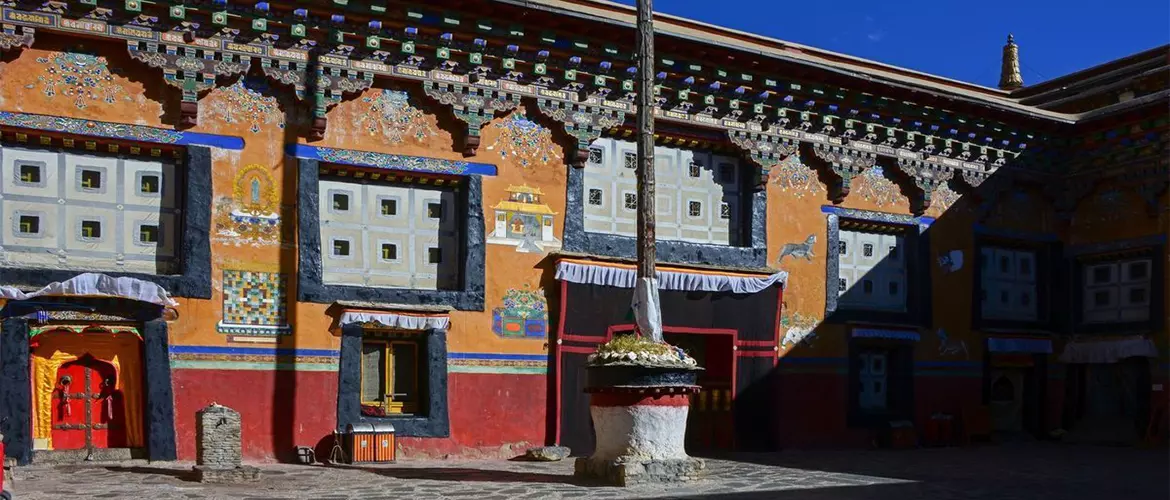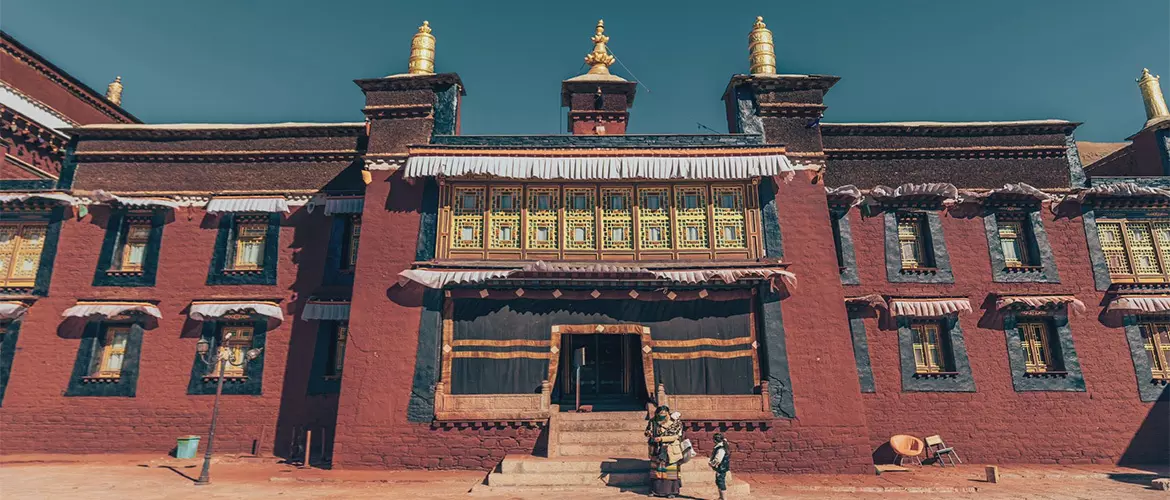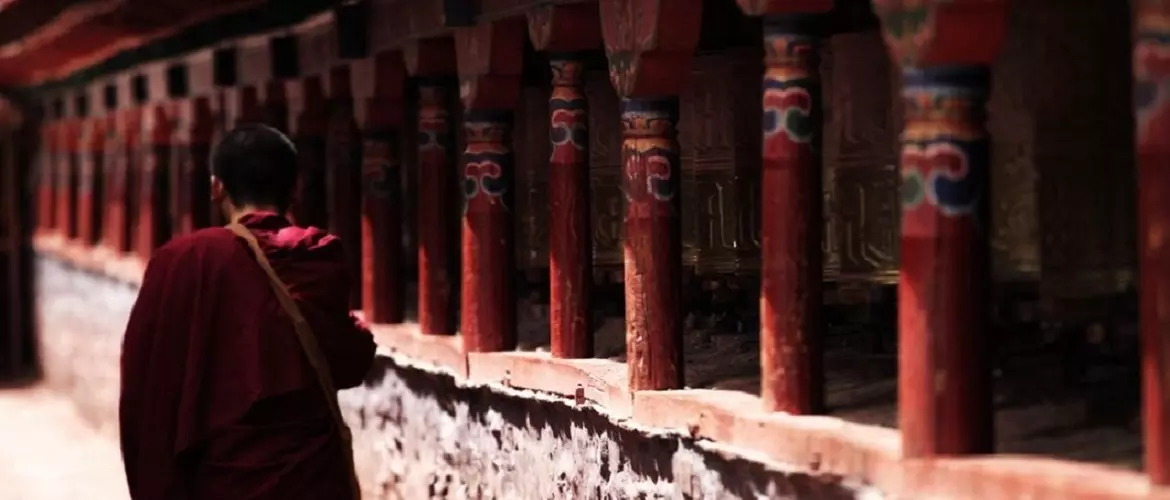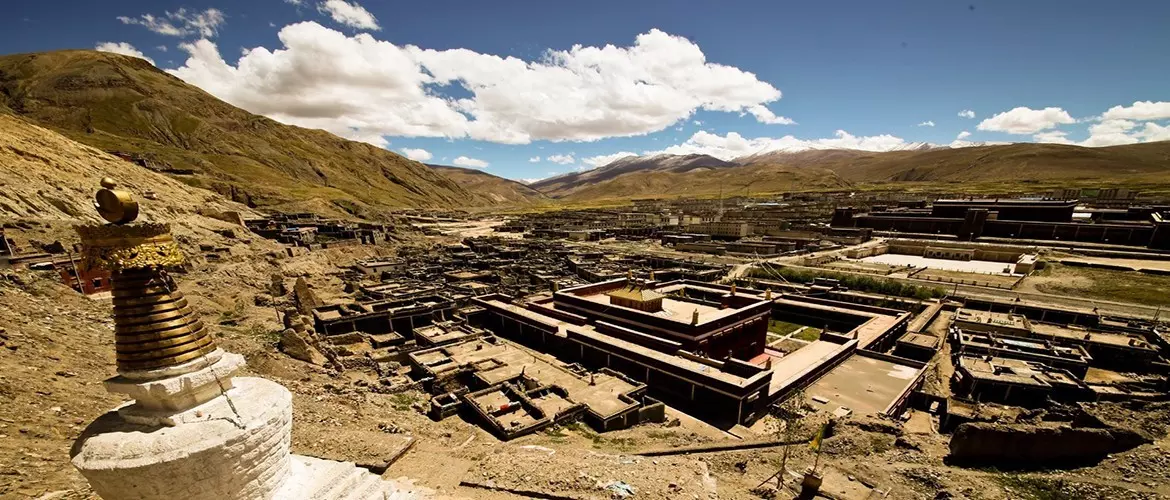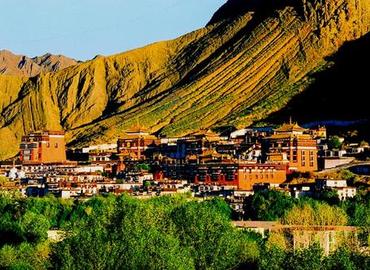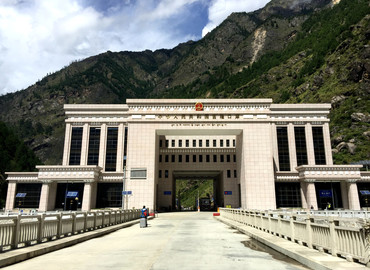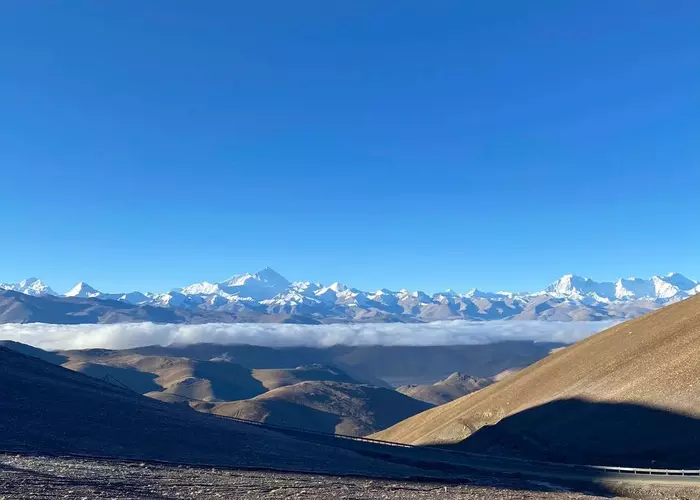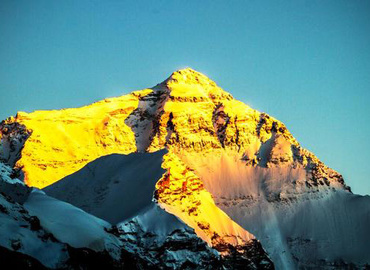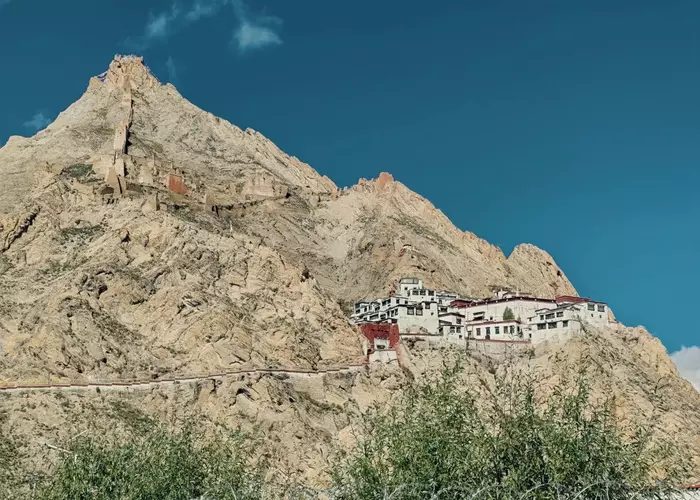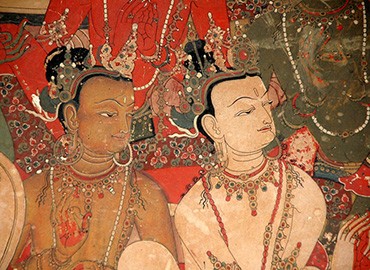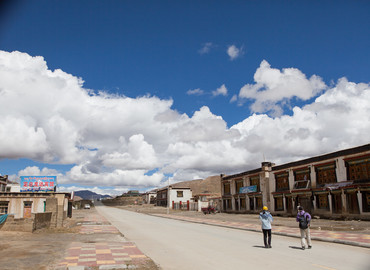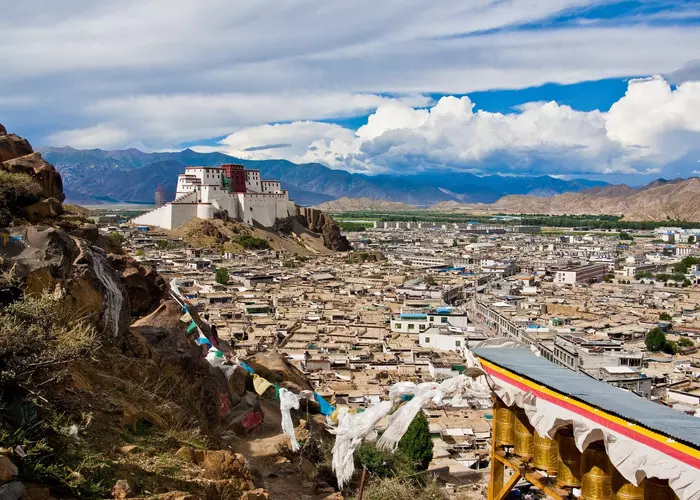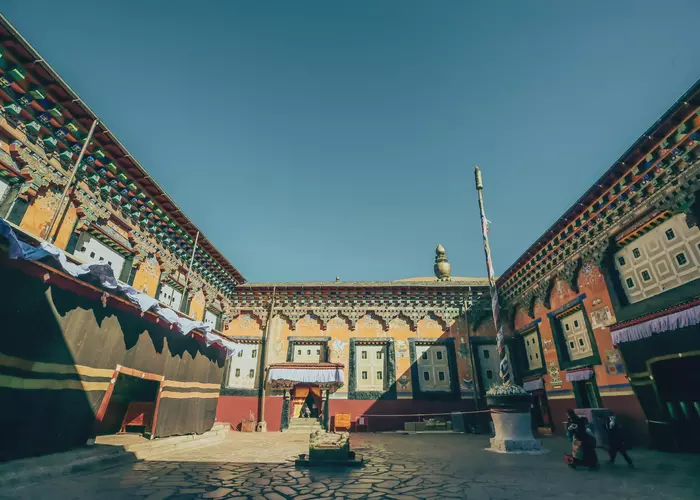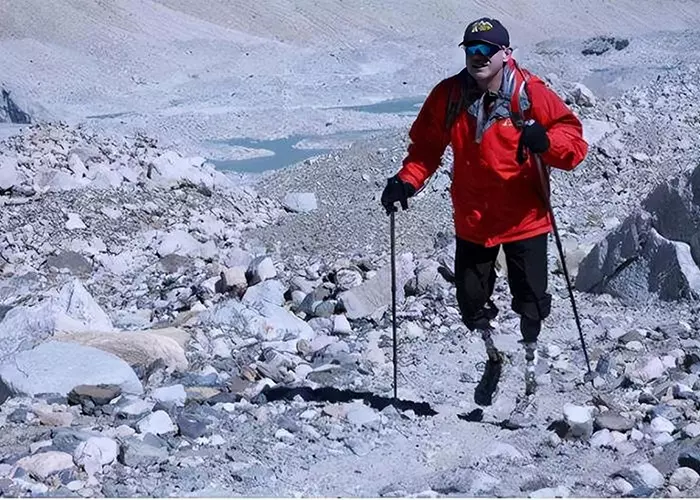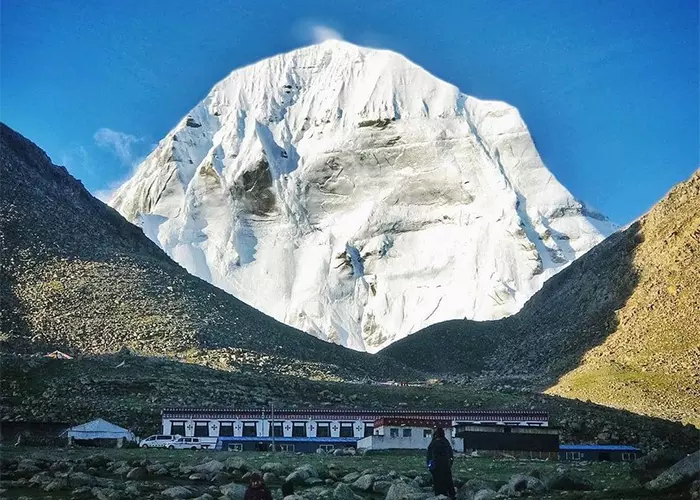Sakya Monastery (萨迦寺) is a Buddhist monastery situated 25 km southeast of a bridge, which is about 127 km west of Shigatse on the road to Tingri in Tibet. It belongs to Sakya County, Shigatse region. It is a monastery of the Sakya Sect of Tibetan Buddhism and the main temple of the Sakya Sect. In Tibetan, the word Sakya means “gray soil” referring to the weathered gray earth on Bonbori Hill where the monastery is located.
The walls of Sakya Monastery are decorated with red, which symbolizes Manjusri, white, which symbolizes Guanyin Bodhisattva, and blue, which symbolizes Vajrapani Bodhisattva, so the Saga sect is commonly known as the Variegated Sect.
In History
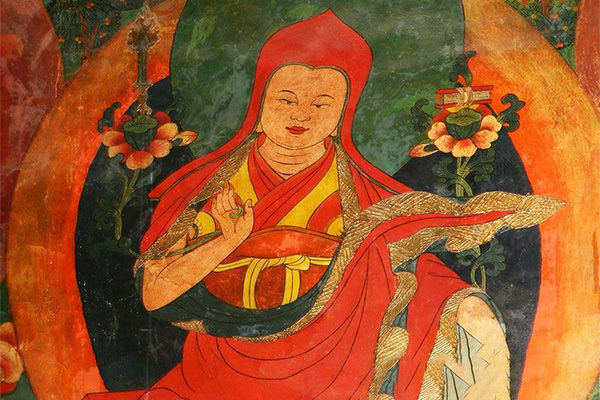 Phags-pa on mural
Phags-pa on muralAs the seat of the Sakya (or Sakyapa) school of Tibetan Buddhism, it was founded in 1073, by Konchok Gyelpo, originally a Nyingmapa monk of the powerful noble family of the Tsang and became the first Sakya Trizin. Its powerful abbots governed Tibet during the 13th and 14th centuries under the overlordship of the Mongol Yuan dynasty after the downfall of the Tibetan Empire until they were eclipsed by the rise of the new Kagyu and Gelug schools of Tibetan Buddhism. The most famous one is Phags-pa, who was appointed as the Grand Master of the Yuan Dynasty by Chinese Emperor Kublai Khan. He also led some Tubo language scholars to recreate Phasps-pa characters, which occupy an important position in the history of Chinese writing.
The Sakya sect does not prohibit marrying wives, and the teaching of Lam Drey is the main method of its practice. The Sakya Sect played an important role in the development of Tibetan culture. When the Sakya Sect assisted the Yuan Dynasty in ruling Tibet, Tibet ended more than 400 years of war, social production developed, and culture and art flourished. At that time, some eminent monks of the Sakya Sect had many translations and works in literature and history.
North and South Temples
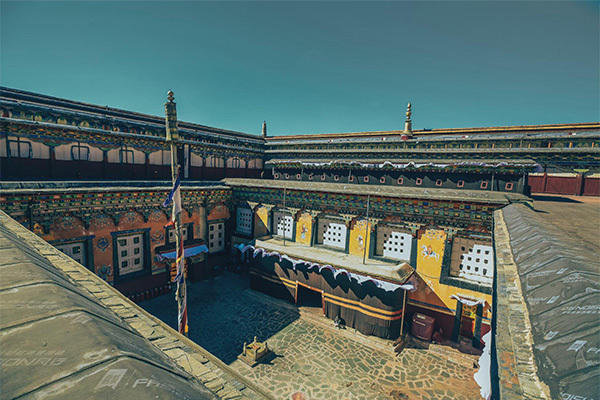 Patio with colorful paintings
Patio with colorful paintingsThe Zhongqu River flows by the monastery, which naturally divides Sakya Monastery into the north and south two temples. The North Temple was built in front of Benbo Mountain on the north bank. It was built in the second year of Yuanfeng (1079) of Song Shenzong. Today, there is still a well-preserved building in the North Temple. There are several Buddhist halls open inside, enshrining the Sakya Dharma King, divine water, the Sakya Dharma King's footprints, etc.
The essence of the Sakya Temple is in the South Temple, which is located on a plain, on the south bank of Shigatse Prefecture. It was first built in 1268, with an area of 14,700 square meters, showing a square surface. There are two circles of city walls with crenels on the walls. In order to facilitate defense, in addition to the strong temple walls, four forts and four turrets were built. Looking from a distance, they are symmetrical and spectacular. There is also a moat outside, the city gate is in the shape of "工", and the entire floor plan is a large "回" character surrounded by a small "回" character, which is useful for war defense.
Highlights of Sakya Monastery
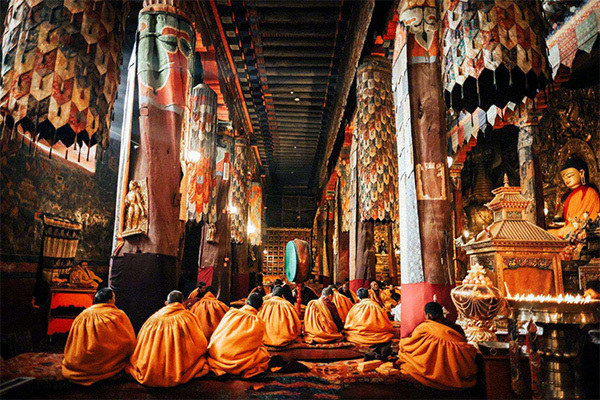 Splendid chapel hall
Splendid chapel hall There are four precious treasures in the Sakya Monastery, namely, Gongbu Guru (the statue of Gonpu God brought from India by Zhuqing Baiwaba), Lan Jie Qudan (a stupa built by the great translator Pabai Luozawa with gushing waters frequently, which is regarded as divine water), the statue of Manjusri Bodhisattva (it is said that the door of wisdom can be opened by reciting the Manjusri Sutra for seven days in front of the statue), and the statue of Yukamu Tara (a Buddha statue enshrined by Phags-pa). Three of the four great treasures are Buddha statues.
There is also preserved in this monastery a conch shell with whorls turning from left to right in Tibetan, Ya chyü dungkar, a present from Kublai to Phagpa. It's said this legendary white conch was used by Sakyamuni, with a history of more than 2,500 years. It is only blown by the lamas when the request is accompanied by a present of seven ounces of silver, but to blow it, or have it blown, is held to be an act of great merit.
Library and Arts
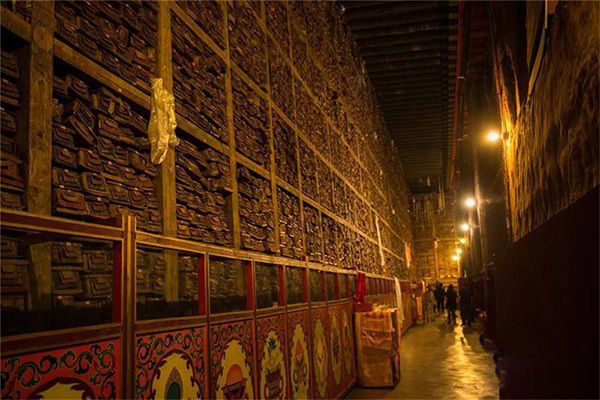 Book Wall of Sakya Monastery
Book Wall of Sakya MonasteryA huge library of as many as 84,000 scrolls was found sealed up in a wall 60 meters long and 10 meters high at Sakya Monastery in 2003. It is expected that most of them will prove to be Buddhist scriptures, although they may well also include works of literature, history, philosophy, astronomy, mathematics, and art. They are thought to have remained untouched for hundreds of years. They are being examined by the Tibetan Academy of Social Sciences.
The architectural features of Sakya Monastery combine the styles of China, India, Nepal and Tibet, and integrate the four into one, harmonious and appropriate. This monastery is not only grand and exquisite in architecture, but also has a large number of cultural relics of great artistic value, such as seals, classics, and Buddha statues. There are more than 3,000 exquisite murals in Sakya Temple, covering a wide range of subjects, involving religion, history, culture and social life. Auspicious animals, decorative patterns, etc., are the main ones, with grand scenes and rich content.
Festivals at Sakya Monastery
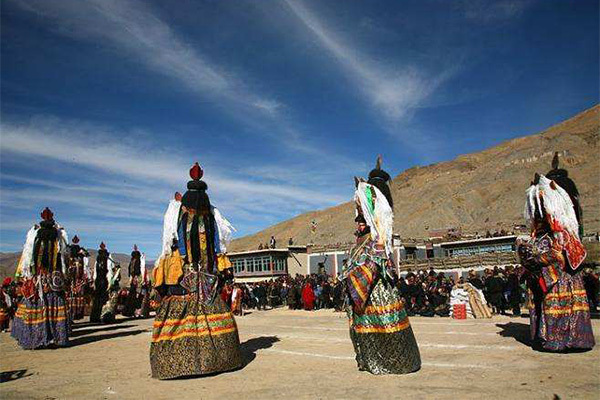 Vajra Dance in winter
Vajra Dance in winterSakya Monastery holds many religious activities every year, among which the larger and unique ones are the summer and winter Vajra Dance of the Dharma Assembly. The summer Vajra dance is held in July of the Tibetan calendar every year, and the winter Vajra dance begins on the 19th of the tenth month of the Tibetan calendar. During the performance of the Vajra dance, the dancers wear masks of the Dharma protector of Sakya Temple and various spirit beasts. The simple storyline of the Vajra dance vividly reflects the basic content of killing demons in the Tantric of Tibetan Buddhism. When the two assemblies are held, tens of millions of monks and laymen from far and near will come to Sakya Monastery to worship and watch, praying that the Vajra dance will bring happiness and auspiciousness to the world.
Conclusion
Sakya Monastery has an important position in Chinese and Tibetan Buddhist history. It is the first monastery of the Sakya Sect of Tibetan Buddhism and the central temple of the Sakya school. There are rich historical, religious, architectural and artistic relics in the monastery, especially a large number of precious books and murals, comparable to Dunhuang literature and art, so Sakya monastery is also known as "the second Dunhuang".
Lhasa-Lhatse-EBC-Shigatse-Lhasa
Enjoy the scenery&culture from Lhasa to EBC and admire the magnificent view of Everest and the beauty of Sakya Temple.
Lhasa - Gyantse - Shigatse - EBC - Shigatse - Lhasa
Escorted by our experienced guide, you can view Tibetan monasteries and the highest peak in the world with a wheelchair.
Lhasa – Shigatse - EBC - Kailash - Shigatse - Lhasa
Explore Tibetan culture more deeply. It's a challenge as it's a pilgrimage tour to the holy Mt. Kailash and Everest.
Email response within 0.5~24 hours.


